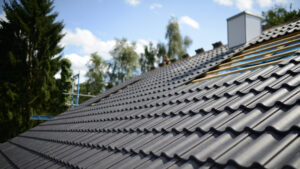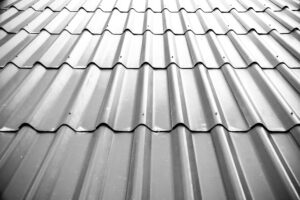Tile Roofing: Advantages and Drawbacks

When it comes to protecting your home from the elements, few decisions are as important as choosing the right roofing material. With the wide range of available options, it can be challenging to determine which one best suits your needs. One popular choice among homeowners is tile roofing. In fact, a recent survey found that nearly 30% of new homes in the United States feature tile roofs. But what exactly makes this material so appealing, and are there any potential downsides to consider? In this article, we’ll take an in-depth look at the pros and cons of tile roofing to help you make an informed decision for your home.
Understanding Roofing Tiles
Before we dive into the advantages and disadvantages of tile roofing, let’s first define what we mean by “roofing tiles.” These are individual units, typically made from materials like clay, concrete, or slate, that are installed in an overlapping pattern to create a watertight seal on your roof. Tile roofs have been used for centuries, with some ancient structures still sporting their original tiled roofs. Today, advances in manufacturing have led to a wide range of styles, colors, and materials to choose from, making tile roofing a versatile option for many homeowners.
The Benefits of Tile Roofing
1. Unmatched Durability
One of the most significant benefits of tile roofing is its exceptional durability. With proper installation and maintenance, a tile roof can last for 50 to 100 years or more, far outlasting other roofing materials like asphalt shingles. This longevity can be attributed to the tile’s resistance to wear and tear, as well as its ability to withstand extreme weather conditions.
2. Excellent Weather Resistance
Tile roofs are known for their outstanding weather resistance. They can withstand high winds, heavy rain, hail, and even fire, providing superior protection for your home. Clay and concrete tiles are particularly effective at resisting damage from hot embers, making them an ideal choice for homes in wildfire-prone areas.
3. Energy Efficiency
Another advantage of tile roofing is its energy efficiency. Tiles have natural insulating properties that help keep your home cooler in the summer and warmer in the winter, reducing your reliance on heating and cooling systems. This can lead to significant energy cost savings over time, making tile roofing a smart investment for environmentally conscious homeowners.
4. Low Maintenance Requirements
Compared to other roofing materials, tiles require relatively little maintenance. They don’t rot, warp, or become infested with insects like wood shakes, and they’re not susceptible to rust like metal roofs. Regular cleaning and occasional repairs may be necessary, but overall, tile roofs are a low-maintenance option that can save you time and money in the long run.
5. Versatility
Tile roofing offers a wide range of design possibilities, allowing you to customize your home’s appearance to suit your personal style. With a variety of colors, shapes, and textures available, you can create a roof that complements your home’s architecture and enhances its curb appeal. Whether you prefer a classic Mediterranean look or a modern, sleek design, there’s a tile option to match your vision.
The Drawbacks of Tile Roofing
1. Heavyweight and Structural Requirements
One of the main disadvantages of tile roofing is its weight. Tiles are much heavier than other roofing materials, which means your home’s structure must be able to support the added load. This may require reinforcing your roof framing, adding to the overall cost and complexity of the installation process.
2. Higher Upfront Costs
Tile roofing is generally more expensive than other roofing options, such as asphalt shingles or metal. The higher upfront costs can be attributed to the cost of the materials themselves, as well as the specialized labor required for proper installation. However, it’s important to consider the long-term value of tile roofing, as its durability and longevity can offset the initial investment over time.
3. Complex Installation Process
Installing a tile roof is a complex and labor-intensive process that requires skilled professionals. Improper installation can lead to leaks, structural damage, and other costly issues down the line. This complexity can also contribute to longer installation times and higher labor costs compared to other roofing materials.
4. Potential for Breakage and Cracking
Although tiles are durable, they can be brittle and prone to cracking or breaking under certain conditions. Heavy impacts from falling tree branches, hailstones, or foot traffic can cause damage to individual tiles, necessitating repairs or replacements. While these issues can be mitigated with proper maintenance and care, it’s important to be aware of the potential for breakage.
5. Maintenance Considerations
While tile roofs are low-maintenance compared to some other options, they do require regular cleaning to prevent the buildup of moss, algae, and other debris. This is especially true in humid or shaded areas where moisture can accumulate. Failure to clean your tile roof regularly can lead to staining and potential damage over time. Additionally, any cracked or broken tiles should be replaced promptly to prevent leaks and further damage.
Exploring Tile Roofing Materials
There are several types of tile roofing materials to choose from, each with its own unique properties and advantages:

1. Clay Tiles
Clay tiles are one of the oldest and most traditional roofing materials, with a history dating back centuries. Made from natural clay that is fired in a kiln, these tiles are known for their distinctive reddish-orange color and classic barrel shape. Clay tiles are durable, fire-resistant, and low-maintenance, making them a popular choice for homeowners who want a traditional, long-lasting roof.

2. Concrete Tiles
Concrete tiles are a more contemporary alternative to clay tiles, offering similar benefits at a lower cost. Made from a mixture of sand, cement, and water, concrete tiles can be shaped and colored to mimic the look of clay, slate, or even wood shakes. They are highly durable, fire-resistant, and able to withstand extreme weather conditions, making them a practical choice for many homeowners.

3. Slate Tiles
Slate tiles are a premium roofing option that offers unparalleled beauty and durability. Made from natural stone, slate tiles have a unique, textured appearance that adds sophistication and charm to any home. They are extremely long-lasting, with a lifespan of 100 years or more, and are resistant to fire, moisture, and insect damage. However, slate tiles are also one of the most expensive roofing options and require specialized installation.

4. Metal Tiles
Metal tiles are a modern twist on the traditional tile roof. These lightweight, durable tiles are typically made from steel or aluminum and coated with a protective finish to prevent rust and corrosion. Metal tiles offer excellent energy efficiency and can mimic the look of clay, slate, or wood while providing superior strength and impact resistance.

5. Solar Tiles
Solar tiles are an innovative roofing option that combines the benefits of traditional tiles with the energy-generating power of solar panels. These tiles are designed to blend seamlessly with your roof, providing a sleek, modern appearance while harnessing the sun’s energy to power your home. While solar tiles are more expensive than traditional roofing materials, they can significantly reduce your energy costs over time and contribute to a more sustainable future.
Choosing the Right Tile for Your Home
When selecting the best roofing tile for your home, there are several factors to consider:
- Climate: Choose a tile that can withstand the specific weather conditions in your area, such as high winds, heavy rain, or extreme temperatures.
- Architectural style: Select a tile that complements your home’s architecture and enhances its overall aesthetic appeal.
- Budget: Consider the upfront costs of the tiles, as well as the long-term value they provide in terms of durability, energy efficiency, and potential energy savings.
- Maintenance requirements: Factor in the level of maintenance required for each type of tile, and choose one that aligns with your lifestyle and preferences.
- Environmental impact: If sustainability is a priority for you, consider tiles that are eco-friendly, such as metal or solar tiles, or those made from recycled materials.
Frequently Asked Questions
How much does a tile roof cost?
The cost of a tile roof can vary widely depending on the material, the size of your home, and the complexity of the installation. On average, homeowners can expect to pay between $10 and $30 per square foot for a new tile roof.
Can I walk on my tile roof?
While it is possible to walk on a tile roof, it’s generally not recommended. The weight and pressure of footsteps can crack or break individual tiles, leading to leaks and other damage. If you must access your tile roof for maintenance or repairs, use extreme caution and consider hiring a professional.
How long does a tile roof last?
With proper installation and maintenance, a tile roof can last for 50 years or more. Some clay and slate tile roofs have been known to last for over a century.
Are tile roofs energy-efficient?
Yes, tile roofs are known for their energy efficiency. The natural properties of materials like clay and concrete help to regulate your home’s temperature, reducing the need for heating and cooling. Some tile materials also have reflective properties that can further enhance energy savings.
How do I maintain my tile roof?
To keep your tile roof in top condition, have it inspected regularly by a professional. Clean your roof periodically to remove moss, algae, and debris, and repair any cracked or broken tiles promptly to prevent leaks. Avoid walking on your tile roof whenever possible to prevent damage.
Conclusion
Tile roofing offers a range of benefits, from durability and weather resistance to energy efficiency and aesthetic appeal. However, it’s essential to weigh these advantages against the potential drawbacks, such as higher upfront costs and complex installation requirements. By understanding the different types of roofing tiles available and considering factors like climate, architectural style, and maintenance needs, you can make an informed decision about whether tile roofing is the right choice for your home. With proper installation and care, a tile roof can provide lasting protection, beauty, and value for your home, making it a worthwhile investment for many homeowners.
Additional Roofing Resources
- Choosing the Best Roof Coating for Your Home
- The Dangers of DIY Roof Repairs
- Do You Need a Drip Edge on Your Roof?
- Choosing the Best Roof Material for Your Coastal Home

Anna has over six years of experience in the home services and journalism industries and serves as the Content Manager at MyHomePros.com, specializing in making complex home improvement topics like HVAC, roofing, and plumbing accessible to all. With a bachelor’s degree in journalism from Auburn University, she excels in crafting localized, comprehensive guides that cater to homeowners’ unique needs. Living on both coasts of the United States has equipped her with a distinctive perspective, fueling her passion for turning any house into a cherished home through informed, personalized decision-making.








